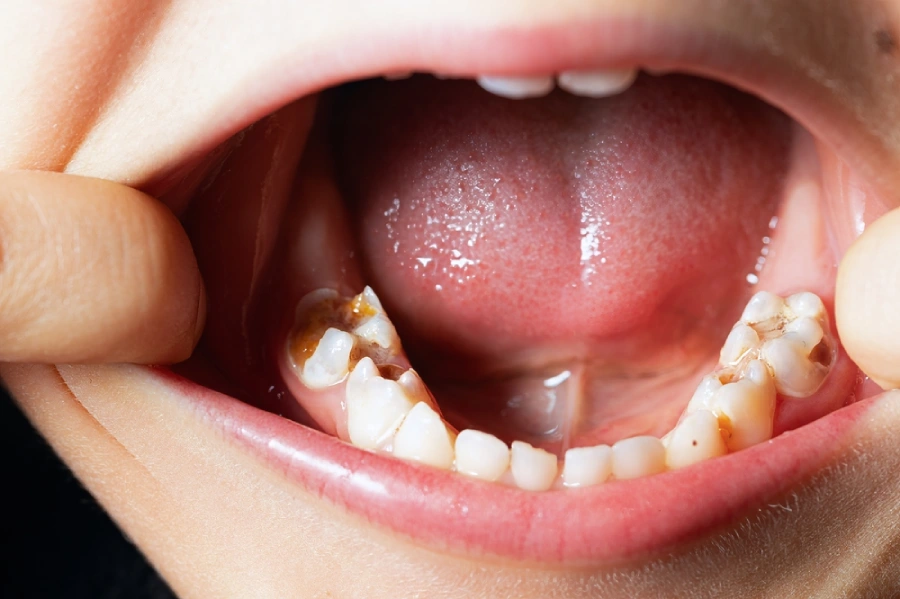
Dental sealants are thin, liquid coatings that are painted onto the surface of the premolars and molars. Once applied, the dentist hardens the sealant material to help prevent the teeth from forming cavities.
Sealants are considered very safe for children and are recommended by most pediatric dentists, as they help protect teeth from the effects of tooth decay and plaque. While sealants are effective for cavity prevention in children, they are not meant to replace having a healthy oral care routine.
How Dental Sealants Work
Dental sealants help to seal and protect the teeth. While they are not considered a substitute for daily flossing and brushing, they are designed to help prevent cavities from forming. When putting sealants on a child’s teeth, the pediatric dentist places them over the grooved and pitted areas in the molars and premolars.
Since these grooves are smaller in children’s teeth than in adult’s, it can be difficult for children to clean thoroughly, and plaque can form within those grooves, eventually creating a cavity.
The dental sealants help to add a layer of protection to the teeth by creating a smooth surface on the teeth, helping to prevent cavities. Sealants can also be placed over cavities in the beginning stages of their formation to help slow down the process of the cavity forming.
What Age Should Kids Get Sealants?
Dental sealants for kids are applied to the permanent molars as soon as they come in. This way, children’s teeth are protected before the decay attacks them and creates a cavity.
Their first permanent molars are between ages 5 and 7, and the second permanent molars are between ages 11 and 14. Therefore, the best time for children to get sealants is between 5 and 14 years old.
Why Children May Need Dental Sealants
The most important reason that children and teenagers are the ideal ages for dental sealants is that they can get the sealants before they experience tooth decay. Sealants are mainly used to help prevent cavities from forming within the grooves of the teeth, which is why they are effective.
Dentists typically recommend sealants if a child’s teeth have deep grooves, fissures, and pits. Pediatric dentists may also recommend sealants if babies have a high risk of tooth decay.
Side Effects of Teeth Sealants
A possible allergy is the only possible side effect of dental sealants, but it is rare. Dental sealants are generally very common and safe, especially for children.
It is important to always discuss any potential side effects with the dentist before applying sealants. Still, sealants are recommended for children because they are considered safe and helpful in preventing cavities.
Different Types of Dental Sealants
There are two different types of dental sealants:
- Composite Resin: This type of sealant is very common. It is a tooth-colored resin material that can be colored and matched to the teeth.
The only drawback of composite resin is that it cannot repair teeth with small cavities, but it is an excellent choice for preventative dental care. Composite resin fillings do not release fluoride onto the teeth but last longer than glass ionomer sealants.
- Glass Ionomer: Glass Ionomer is a transparent acrylic material most common in pediatric dentistry, as it releases small amounts of fluoride mineral on children’s teeth.
This glass ionomer is the top choice of sealants for children because it protects the teeth from tooth decay and bacteria and protects the teeth with fluoride to help strengthen teeth enamel.
Are Dental Sealants Worth It for Kids?
Dental sealants are highly effective in preventing cavities in children’s teeth. If you want to know if kids need dental sealants, they are worth it for kids.
Sealants are especially beneficial between the ages of 5 and 14. Once the sealants are applied, they protect 80 percent of cavities for up to two years and 50 percent of cavities for up to four years.
Dental Sealants: Additional FAQ
Are sealants safe for children’s teeth?
Dental sealants are very safe for children’s teeth. They have been deemed safe by the American Dental Association (ADA), the Food and Drug Administration (FDA), and the Center for Disease Control and Prevention (CDC).
Do kids need sealants?
It is recommended by most dentists that children get sealants on their premolars and molars between the ages of 5 and 14. Without sealants, kids are more susceptible to getting cavities.
The sealants help to smooth out the grooves within the teeth, making it easier for them to be cleaned. Without sealants, children may need to get multiple cavities filled due to the buildup of bacteria and plaque within the grooves of the molars and premolars.
Does insurance cover the cost of sealants?
Many dental plans cover the cost of dental sealants for children under the age of 18. However, sealants for adults are typically not covered under insurance.
To ensure that sealants are covered under insurance, you should contact your dental insurance carrier to verify that sealants are covered for children.
How long do sealants last?
Generally, sealants can last between two and four years for children before they need to be replaced. During every appointment for a cleaning, the dentist will check to ensure that the sealants are still in good condition and will let you know when it is time for them to be replaced with new sealants.
Conclusion
Dental sealants are a safe and effective way to help prevent bacteria and plaque from forming on children’s teeth, which also helps prevent cavities from forming.
While sealants help prevent tooth decay, children need to maintain a good oral hygiene routine daily by brushing twice a day with fluoride toothpaste, flossing between the teeth daily, and visiting a pediatric dentist regularly.
Every child deserves a great smile, which is why The Super Dentists go above and beyond traditional dental services. The Super Dentists provide a fun and memorable experience during every dental visit in San Diego. Schedule your visit today with The Super Dentists!










